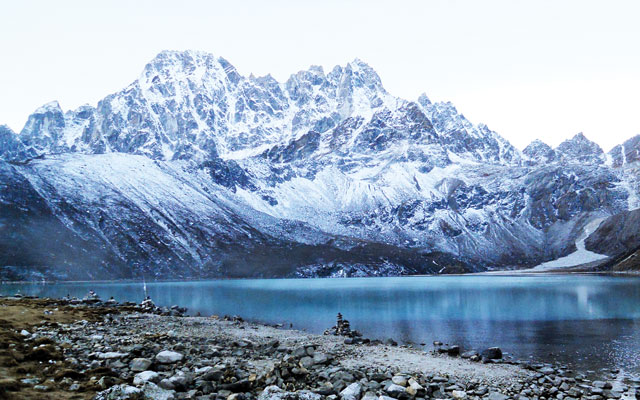Expeditions have tried without success to demystify the legendary beast with an existence built on anecdotal reports and not scientific corroboration.
 Shaggy critters with conical heads and pointed ears, Sherpa folklore portrays yetis as herculean enough to carry away husky yaks and feast on them. Head to toe, they are reputed to reach a staggering 8 ft tall, and haunt the most remote corners of the Khumbu and beyond, rarely troubling human settlements...aside from the dreaded Midre yeti. Midre is one of three types of yeti outlined in Sherpa fable. There are Drema, the messenger of misfortune, Chuti, who preys on livestock, and Midre, who harasses all animals, including ill-fated humans.
Shaggy critters with conical heads and pointed ears, Sherpa folklore portrays yetis as herculean enough to carry away husky yaks and feast on them. Head to toe, they are reputed to reach a staggering 8 ft tall, and haunt the most remote corners of the Khumbu and beyond, rarely troubling human settlements...aside from the dreaded Midre yeti. Midre is one of three types of yeti outlined in Sherpa fable. There are Drema, the messenger of misfortune, Chuti, who preys on livestock, and Midre, who harasses all animals, including ill-fated humans.
At Khumjung Monastery, in the Sherpa homeland of the Khumbu, a celebrated yeti scalp and hand bones have been treasured away in a cabinet in the main prayer hall and viewable to all for a small ‘donation’ fee. Nowadays, only the scalp remains, with the hand bones lost to the tides of time. No one knows where the missing hand relics have vanished. Sir Edmund Percival Hillary took these same specimens on a world tour in the 1960s. His attempt to verify an ‹anomalous primate› did not meet with the same dazzling success as his mountaineering exploits, including standing atop Sagarmatha (Everest) with Tenzing Norgay Sherpa for the first time in recorded history. Science was unable to authenticate a yeti on Hillary’s tour. Other expeditions have tried without success to demystify the legendary beast with an existence built on anecdotal reports and not scientific corroboration.
Most notably, another mountaineering luminary, Reinhold Messner, undertook an inspired hunt for yeti in the vast Himalayan wilderness after encountering a mysterious creature in eastern Tibet. He detailed the fascinating search in My Quest for the Yeti: The World’s Greatest Mountain Climber Confronts the Himalayas’ Deepest Mystery (St. Martin’s Press, April 2000). Messner eventually reckoned after 11 years of searching that the yeti is a type of bear.
 His quest has come full circle with a genetic study out of Oxford University—Genetic analysis of hair samples attributed to yeti, bigfoot and other anomalous primates, published July, 2014, in the proceedings of the Royal Society B: Biological Sciences. Researchers matched DNA from hair samples found in the Himalayas with a prehistoric bear from the Pleistocene epoch, a period ranging between roughly 11,500 to 2,500,000 years ago.
His quest has come full circle with a genetic study out of Oxford University—Genetic analysis of hair samples attributed to yeti, bigfoot and other anomalous primates, published July, 2014, in the proceedings of the Royal Society B: Biological Sciences. Researchers matched DNA from hair samples found in the Himalayas with a prehistoric bear from the Pleistocene epoch, a period ranging between roughly 11,500 to 2,500,000 years ago.
The search for a live specimen continues, while the yeti remains a preeminent figure of cryptozoology, as well as a pop-culture icon. Nowadays, the name of yeti, sometimes accompanied by a contrived image, is used to promote everything from mountain bikes to restaurants, and at least one bank, a pub, spa, hotel, bakery, and even a golf course (part of the Fublbari Resort in Pokhara, Nepal) and much more.
The legendary resident of the Khumbu has beguiled the human race from the Himalayas to the globe’s antipodes and back again. If you visit the breathtaking highlands of Nepal, keep watch for a chance to capture a first-ever photo of the shaggy yeti galumphing about in its natural habitat, perhaps dragging away a husky yak for a lonely supper in a far corner under spiky, snow-dressed peaks towering into steely skies. Regardless of success with a camera, the surrounding Himalayan mountain scenery along the way will be a visual climax for a long time to come, and well worth the adventure.
Readers inspired to make a trekking journey of their own in the Himalayan paradise of the Khumbu can contact any number of agencies for more information. Keep on trekking, keep on enjoying the outdoor nirvana of Nepal.
Alonzo Lyons is the author of The Best Little Guidebook for Trekking the Everest Region, and The Guerrilla Trek and Yarsa Trails--Off the Beaten Path in Rugged Western Nepal (his Nepal Insider Editions are self-published and available on Amazon and Kindle). He is also a trekking guide with Neo Horizon Travels
(www.neohorizontravels.com), an outfitter specializing in journeys to Nepal’s wild west, including the Guerrilla Trek and journeys to highland yarsagumba caravan destinations.










